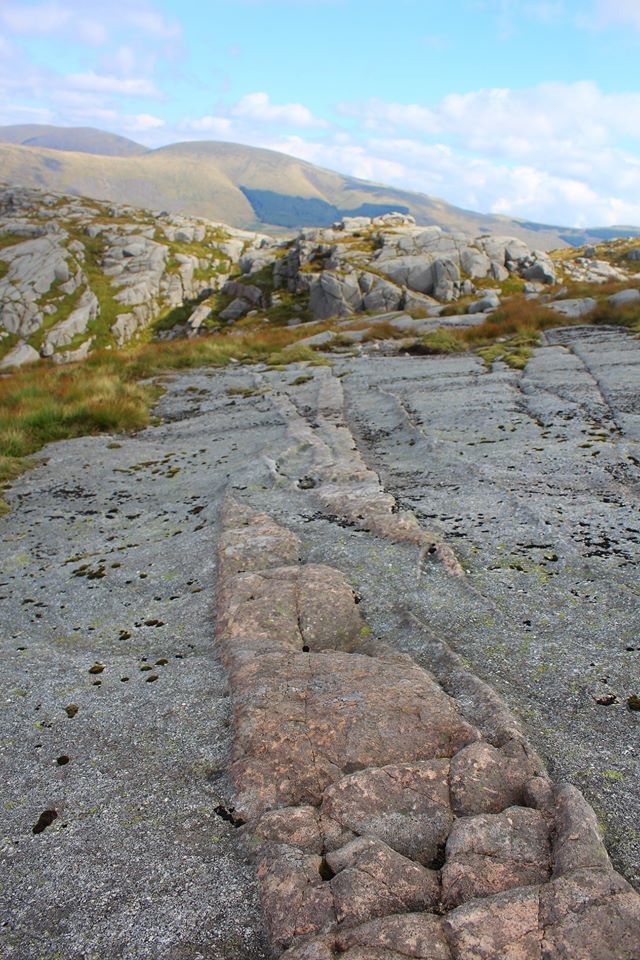Devorgilla Bridge is one of the oldest bridges in Scotland, and is a great place to watch the mightly Nith on its way to the Solway. We are here to look at the steps up to the bridge, and two particular features within the steps. For some of us, the rugged slopes and tops of the Galloway Hills are out of our reach, so this EarthCache helps to show you some features without the midges, the bogs and a long walk in and out.
The steps are made from granite.
Granite is a common type of igneous rock. Igneous rock is one of the three main rock types , the others being sedimentary and metamorphic. Igneous rock forms by crystallisation either below the surface as intrusive (plutonic) rocks or on the surface as extrusive (volcanic) rocks. As the magma pushes up from deep, it eventually slowly cools into a solid, and forms rock. An intrusive rock is any form of igneous rock that forms within the crust of the planet. Large areas of magma that solidify underground before they reach the surface are known as plutons .Granitic rocks mainly consist of feldspar, quartz, mica and amphibole minerals, which form an interlocking matrix of feldspar and quartz with scattered darker biotite mica and amphibole (often hornblende) peppering the lighter colour minerals.
Quartz is the second most abundant mineral in the continental crust. It is a defining constituent of granite and other felsic igneous rocks, and is very common in sedimentary rocks such as sandstone. While the majority of quartz crystallizes from molten magma, much quartz also chemically precipitates in the magma from hot hydrothermal veins as gangue, sometimes with ore minerals like gold, silver and copper. It is formed from silicone dioxide. It can come in a variety of colours, but in the case of this type of granite it tends to be clear or milky coloured.
Feldspar is one of the most abundant group of minerals in the earth's crust, forming about 60% of terrestrial rocks. Most deposits offer sodium feldspar as well as potassium feldspar and mixed feldspars. It can be white, pale grey or pink.
Biotite Mica is typically black to brown in colour. The darker colour increases due to increased iron content.
Amphibole forms prism or needlelike crystals, and can be green, black, colourless, white, yellow, blue, or brown.
In Dumfries and Galloway there are two main areas where granite can be found, in specific areas known as plutons.Large areas of magma that solidify underground before they reach the surface are known as plutons. In the south of Scotland there are two large plutons, the Loch Doon pluton, which extends from Loch Dee north to Loch Doon , and the Dalbeattie / Criffel pluton, which is to the south west of Dumfries.
We are here to look at and learn about two features which can be found in granite. These are xenoliths and aplites.
Aplite, is an intrusive igneous rock, with a similar composition to granite, but with much finer crystals, under 1 mm in diameter. The dominant materials are quartz and feldspar. The term 'aplite' or 'aplitic' is often used as a textural term to descrie veins of quartz and feldspar with a fine to medium-grain "sugary" texture. Aplites are usually very fine-grained, white, grey or pinkish, and their constituents are visible only with the help of a magnifying lens. The aplites of granite areas, are the last part of the magma to crystallize, which has happened rapidly, with the ingredients solidifying almost at the same time. Aplites can also be first formed as they can be the end of the 'fingers' from the magma body in to the bedrock. If you take your time to look around the steps, you will notice a distinct line in the granite, this is an aplites.

An example of an aplite on Craignaw in the Galloway Hills.
So what is a Xenolith?
Xenoliths are odd shaped, which are a different colour than the bulk of the granite rock. Xenolith is greek for a foreign rock, bascially it is a piece of rock trapped in magma. As explained above, granite is an igneous rock, this is a type of rock formed through the cooling and solidification of magma. A xenolith is a rock embedded in magma while the magma was cooling. As the molten material rises, it tears off bits and pieces of the magma pipe, or roof / wall of a pluton in which it was travelling in which it is traveling. These bits and pieces, trapped in the magma but not melting into it, become xenoliths. Crystals that are torn from the sides of magma pipes are called xenocrysts. As the magma flows out on to the surface of the Earth, or remains as a body within the crust, it is cooled, and various types of igneous rocks could be formed. Xenoliths usually have a different colour and density when compared to the surrounding rock, they can be small or large.
This being an EarthCache, in order to log it, I ask that you answer some questions. Please send them to me, and do not include them in your log. You can send them to me by using the message facility or email, both of which can be found by looking at my profile.
1. Please have a look at the steps, on which step can you find an aplite?
2. Please measure the width of the aplite and describe its colour and how it contrasts to the surrounding granite.
3. At what angle in degrees does the aplite cross the granite step?
4. Please have a look at the steps, on which step can you find the xenolith?
5. Please describe its shape, colour and diameter.